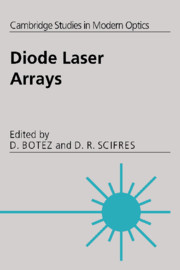Book contents
- Frontmatter
- Contents
- List of contributors
- Preface
- 1 Monolithic phase-locked semiconductor laser arrays
- 2 High-power coherent, semiconductor laser, master oscillator power amplifiers and amplifier arrays
- 3 Microoptical components applied to incoherent and coherent laser arrays
- 4 Modeling of diode laser arrays
- 5 Dynamics of coherent semiconductor laser arrays
- 6 High-average-power semiconductor laser arrays and laser array packaging with an emphasis on pumping solid state lasers
- 7 High-power diode laser arrays and their reliability
- 8 Strained layer quantum well heterostructure laser arrays
- 9 Vertical cavity surface-emitting laser arrays
- 10 Individually addressed arrays of diode lasers
- Index
9 - Vertical cavity surface-emitting laser arrays
Published online by Cambridge University Press: 10 November 2009
- Frontmatter
- Contents
- List of contributors
- Preface
- 1 Monolithic phase-locked semiconductor laser arrays
- 2 High-power coherent, semiconductor laser, master oscillator power amplifiers and amplifier arrays
- 3 Microoptical components applied to incoherent and coherent laser arrays
- 4 Modeling of diode laser arrays
- 5 Dynamics of coherent semiconductor laser arrays
- 6 High-average-power semiconductor laser arrays and laser array packaging with an emphasis on pumping solid state lasers
- 7 High-power diode laser arrays and their reliability
- 8 Strained layer quantum well heterostructure laser arrays
- 9 Vertical cavity surface-emitting laser arrays
- 10 Individually addressed arrays of diode lasers
- Index
Summary
Introduction
Semiconductor diode lasers emitting normal to the substrate plane, known as surface-emitting lasers, are extremely promising for addressing a range of applications from optical interconnects, optical communications and optical recording to remote sensing. The most promising aspect perhaps lies in the prospect of eliminating low yield laser fabrication steps, i.e. laser packaging processing including wafer lapping, cleaving and dicing, facet coatings and diode bonding. The possibility of being able to make any number of lasers anywhere on a wafer is also an increasingly important factor for applications such as optical interconnects. At present two completely different approaches are aimed at realizing surface-emitting lasers. The first represents an extension of the existing technology for semiconductor edge-emitting lasers that uses a 45° slanted mirror or a second-order grating to vertically couple the light out (Figure 9.1(1). (2)). The second, pioneered by K. Iga in 1979, uses highly reflective mirrors to clad the active region, resulting in a vertical cavity that produces an output beam propagating normal to the substrate surface (Figure 9.1(3)).
The vertical cavity design offers important advantages over other surface-emitting laser designs. The unique topology of a vertical cavity facilitates large-scale processing, on-wafer testing and pre-process screening. The small lateral dimensions allow for fabrication of large 2-D arrays with high packing density and integration with other optical and electronic devices.
- Type
- Chapter
- Information
- Diode Laser Arrays , pp. 368 - 413Publisher: Cambridge University PressPrint publication year: 1994
- 2
- Cited by



